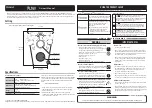
D-2
IEEE-488 Bus Overview
Introduction
Basically, the IEEE-488 bus is a communication system between two or more electronic
devices. A device can be either an instrument or a computer. When a computer is used on the
bus, it serves to supervise the communication exchange between all the devices and is known
as the controller. Supervision by the controller consists of determining which device will talk
and which device will listen. As a talker, a device will output information and as a listener, a
device will receive information. To simplify the task of keeping track of the devices, a unique
address number is assigned to each one.
On the bus, only one device can talk at a time and is addressed to talk by the controller. The
device that is talking is known as the active talker. The devices that need to listen to the talker
are addressed to listen by the controller. Each listener is then referred to as an active listener.
Devices that do not need to listen are instructed to unlisten. The reason for the unlisten instruc-
tion is to optimize the speed of bus information transfer since the task of listening takes up bus
time.
Through the use of control lines, a handshake sequence takes place in the transfer process of
information from a talker to a listener. This handshake sequence helps ensure the credibility of
the information transfer. The basic handshake sequence between an active controller (talker)
and a listener is as follows:
1.
The listener indicates that it is ready to listen.
2.
The talker places the byte of data on the bus and indicates that the data is available to
the listener.
3.
The listener, aware that the data is available, accepts the data and then indicates that the
data has been accepted.
4.
The talker, aware that the data has been accepted, stops sending data and indicates that
data is not being sent.
5.
The listener, aware that there is no data on the bus, indicates that it is ready for the next
byte of data.
Bus description
The IEEE-488 bus, which is also frequently referred to as the GPIB (General Purpose Inter-
face Bus), was designed as a parallel transfer medium to optimize data transfer without using
an excessive number of bus lines. In keeping with this goal, the bus has only eight data lines
that are used for both data and with most commands. Five bus management lines and three
handshake lines round out the complement of bus signal lines.
A typical set up for controlled operation is shown in Figure D-1. Generally, a system will
contain one controller and a number of other instruments to which the commands are given.
Device operation is categorized into three operators: controller, talker, and listener. The con-
troller does what its name implies; it controls the instruments on the bus. The talker sends data
while a listener receives data. Depending on the type of instrument, any particular device can
be a talker only, a listener only, or both a talker and listener.
Summary of Contents for 6430
Page 26: ......
Page 32: ......
Page 78: ...2 14 Connections ...
Page 98: ...3 20 Basic Source Measure Operation ...
Page 138: ...5 30 Source Measure Concepts ...
Page 156: ...6 18 Range Digits Speed and Filters ...
Page 168: ...7 12 Relative and Math ...
Page 176: ...8 8 Data Store ...
Page 202: ...9 26 Sweep Operation ...
Page 248: ...11 22 Limit Testing ...
Page 310: ...16 6 SCPI Signal Oriented Measurement Commands ...
Page 418: ...17 108 SCPI Command Reference ...
Page 450: ...18 32 Performance Verification ...
Page 477: ...A Specifications ...
Page 489: ...B StatusandErrorMessages ...
Page 498: ...B 10 Status and Error Messages ...
Page 499: ...C DataFlow ...
Page 503: ...D IEEE 488BusOverview ...
Page 518: ...D 16 IEEE 488 Bus Overview ...
Page 519: ...E IEEE 488andSCPI ConformanceInformation ...
Page 523: ...F MeasurementConsiderations ...
Page 539: ...G GPIB488 1Protocol ...
Page 557: ......
















































